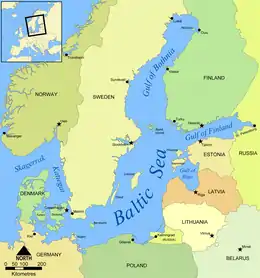Baltic region
The terms Baltic Sea Region, Baltic Rim countries (or simply the Baltic Rim), and the Baltic Sea countries/states refer to slightly different combinations of countries in the general area surrounding the Baltic Sea, mainly in Northern Europe. The term "Baltic states" refers specifically to one such grouping.

Countries surrounding the Baltic Sea
Etymology
The first to name it the Baltic Sea (Latin: Mare Balticum) was 11th century German chronicler Adam of Bremen.
Denotation
Depending on the context the Baltic Sea Region might stand for:
- The countries that have shorelines along the Baltic Sea: Denmark, Estonia, Finland, Germany, Latvia, Lithuania, Poland, Russia, and Sweden.
- The group of countries that are members of the inter-governmental Baltic Assembly and Baltic Council of Ministers,[1] and generally referred to by the shorthand, Baltic states:[2][3][4] Estonia, Latvia, and Lithuania.
- Estonia, Latvia, Lithuania and Kaliningrad Oblast of Russia, exclaved from the remainder of Russia.[5]
- Historic East Prussia and the historical lands of Livonia, Courland and Estonia (Swedish Estonia and Russian Estonia).
- The former Baltic governorates of Imperial Russia: Today's Estonia and Latvia (excluding parts of modern Eastern Latvia that were part of Vitebsk Governorate).
- The countries on the historical British trade route through the Baltic Sea, i.e. including the Scandinavian Peninsula (Sweden and Norway).
- The negotiating members of the Grand Baltic Entente also known as the Baltic League: Finland, Estonia, Latvia, Lithuania, Poland.[6]
- Members of the Council of the Baltic Sea States (CBSS),[7] are the countries[lower-alpha 1] with shorelines along the Baltic Sea, in addition to Norway, Iceland and the European Commission.
- The islands of the Euroregion B7 Baltic Islands Network, which includes the islands and archipelagos Åland (autonomous region of Finland), Bornholm (Denmark), Gotland (Sweden), Hiiumaa (Estonia), Öland (Sweden), Rügen (Germany), and Saaremaa (Estonia).[9]
- On historic Scandinavian and German maps, the Balticum sometimes includes only the historically or culturally German-dominated lands, or provinces, of Estonia, Livonia, Courland and Latgale (corresponding to modern Estonia and Latvia), East Prussia, Samogitia (corresponding to modern Western Lithuania) as well as sometimes Pomerania, Kashubia, while the historically less-Germanized Eastern Lithuania is occasionally excluded.
- In geology, the Baltic Shield includes Fennoscandia, parts of northwestern Russia and the northern Baltic Sea.[10][11]
See also
Notes
- State members of CBSS: Denmark, Estonia, Finland, Germany, Iceland, Latvia, Lithuania, Norway, Poland, Russia and Sweden.[8]
References
- Republic of Estonia; Republic of Latvia; Republic of Lithuania (1994). Declaration on Unity and Co-operation by the Republic of Estonia, Republic of Latvia and Republic of Lithuania (PDF). Council of Baltic States. Archived from the original (PDF) on 7 May 2019. Retrieved 2 June 2021.
- Misiunas, Romuald J; Bater, James H (25 May 2006). "Baltic states". Encyclopædia Britannica (Online ed.). Archived from the original on 11 June 2008. Retrieved 2 June 2021.
- Ministry for Foreign Affairs of the Republic of Latvia. "Co-operation among the Baltic States". Republic of Latvia. Archived from the original on 4 December 2008. Retrieved 2 June 2021.
- Republic of Estonia. "Baltic Cooperation". Ministry of Foreign Affairs. Archived from the original on 6 May 2017. Retrieved 28 May 2018.
- «The Baltic region includes the Baltic republics and the Kaliningrad region of the RSFSR "» — Baltic region in the Great Soviet Encyclopedia, 1969–1978 (in Russian)
- Townsend, Mary Evelyn (September 1921). The Baltic States. The Institute of international education.
- European Commission. "CBSS - Council of Baltic Sea States". knowledge4policy.ec.europa.eu. European Union. Archived from the original on 2 June 2021. Retrieved 2 June 2021.
The Council of the Baltic Sea States is an overall political forum for regional inter-governmental cooperation. The Members of the Council are the eleven states of the Baltic Sea Region as well as the European Commission.
- Council of the Baltic Sea States. "CBSS - About Us". Archived from the original on 10 May 2021. Retrieved 2 June 2021.
- B7 Steering Committee (8 September 2004). "Charter of the B7" (PDF). B7 Baltic Islands Network. Archived (PDF) from the original on 14 June 2021. Retrieved 30 June 2021.
- Dunbar, Moira (2004). "Arctic: Geology". Encyclopædia Britannica. Archived from the original on 24 August 2022. Retrieved 30 June 2021.
- Beckholmen, Monica; Tirén, Sven A (September 2008). "The geological history of the Baltic Sea: A review of the literature and investigation tools". Swedish Radiation Safety Authority - Strålsäkerhetsmyndigheten. ISSN 2000-0456. Report number: 2009:21. Archived from the original on 9 July 2021. Retrieved 30 June 2021.
Further reading
- Norbert Götz. "Spatial Politics and Fuzzy Regionalism: The Case of the Baltic Sea Area." Baltic Worlds 9 (2016) 3: 54–67.
External links
Wikimedia Commons has media related to Baltic region.
- Official website of the Council of the Baltic Sea States
- The Baltic Sea Information Centre (archived 8 February 2008)
- EU Baltic Sea Region Strategy (EUSBSR) – a strategy aiming to accelerate the integration of the region
- The Baltic University Programme – a university network focused on a sustainable development in the Baltic Sea region (archived 10 June 2010)
- Baltic Sea Region Spatial Planning Initiative VASAB
- Baltic Sea Region Programme 2007–2013
- Vifanord – a digital library that provides scientific information on the Nordic and Baltic countries as well as the Baltic region as a whole.
This article is issued from Wikipedia. The text is licensed under Creative Commons - Attribution - Sharealike. Additional terms may apply for the media files.